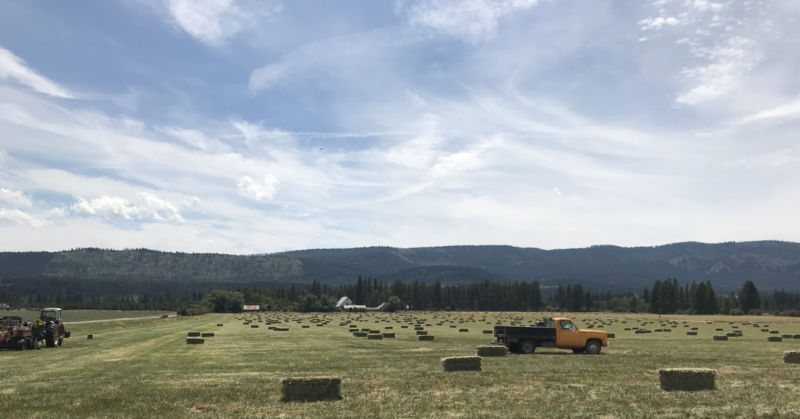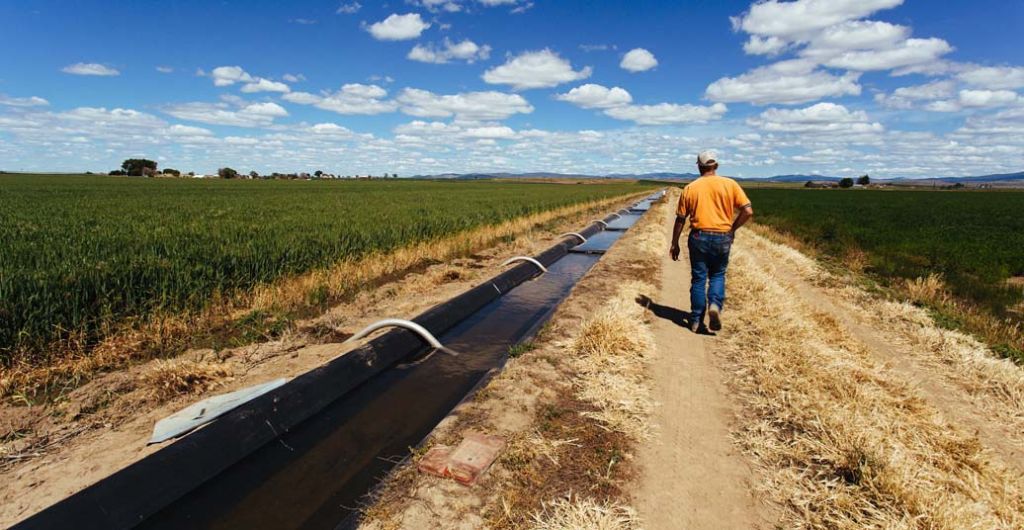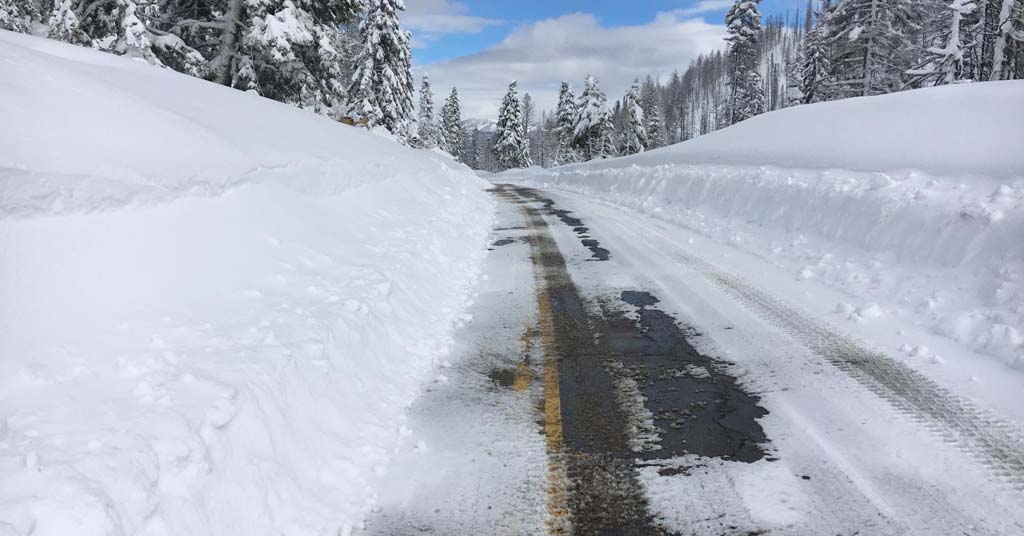Water re-distribution practices being developed in the Columbia River Basin will likely have global impact

Pioneering practice: With help from a water bank, historic Masterson Ranch is now a dry farm. Photo courtesy Kathi Masterson
By Jordan Rane. August 6, 2020. Seven years ago, in central Washington’s Kittitas County, hay rancher Kathi Masterson faced a situation that might seem surprising in drought-prone farm country: far more water than she needed for her 260 acres of cropland.
As a first rights holder to water on one of the oldest homesteads in central Washington—with water rights dating to 1883, famed Old West icon Bat Masterson was a nephew of the property’s founder—the 2,000-acre Masterson Ranch was entitled to a steady supply of irrigation water flowing into the property along a four-mile-long earthen ditch from the neighboring Teanaway River.
“We hadn’t used the ditch in a number of years,” says Masterson.
Masterson was approached by a representative from the Washington Water Trust, a nonprofit dedicated to protecting and restoring stream flow and water quality throughout the state.
“I’m quite a conservationist, and so when he asked me, ‘What would you think about doing a water bank?’ I thought, ‘Well, gosh, that might be OK,’” says Masterson. “I was familiar with what a water bank was, and it sounded like it could work out well for everyone.”
It did.
In an increasingly common process overseen by the Washington State Department of Ecology’s Trust Water Rights Program, Masterson sold (or “banked”) her full water right to a neighboring farm, which used the bulk of it for river restoration in a habitat-threatened patch of the lower Teanaway.
That additional water would “keep the river cooler and the steelhead, rainbow and bull trout stock a lot healthier and happier,” says Masterson.
The water rights transfer provided funds for the historic Masterson ranch, and added incentive to make the property less water dependent.
“We’re a dry farm now, which has its challenges, but overall it’s been a good move for us,” says Masterson, who considers her water banking decision a win-win-win. “It was a good move for everyone—including the fish.”
The story of the Masterson Ranch, in essence, illustrates how “water banks” work every day in the Columbia River Basin.
What is a water bank?
Pioneered in various forms over the past century, water banks are now implemented across the globe from Australia and Spain to most of the Western United States.
Not a physical bank, “water banking” describes the voluntary exchange of water rights from one form of use to another in areas of increasingly limited supply—for example, from a farmer’s old fields to a thirsty new residential community.
MORE ON CI: Farmers respond to Trump’s Navigable Waters Protection Rule
That’s an easy enough concept to understand. But, given the byzantine network of water laws, practices, rights holders and consumers in the West, any ripples of simplicity to the process have long gone under the bridge.
To navigate a more nuanced understanding of water banking in its most active testing grounds like Washington, Oregon and Idaho is to splosh through an undertow of bone-dry water lingo—mitigation credits, regulatory caps, usufructuary rights, net water savings, prior appropriation.

Hay maker: Kathi Masterson. Photo courtesy Kathi Masterson
In addition, the throng of state, municipal, nonprofit and private entities with a hand in the Columbia River Basin’s water market—where water is paradoxically a public resource that’s also private property—is a crowded beach of state agencies, councils, trusts, institutes, conservancies and their respective acronyms, including the NPCC, WWT, OWRD, DBWTP and many more.
The lack of uniformity in managing rights to limited water supplies in today’s stressed water market can make the process as clear as silt.
“All states are governed by their own water statutes, so water banks have evolved with their own different terms and are used in different ways, with any given state just trying to react to its own diverse needs of water issues,” says Kelsey Collins, statewide trust water coordinator for Washington’s Department of Ecology, which oversees the state’s water banks through its Trust Water Rights Program. “That’s actually been one of the bigger challenges moving forward. Just coming up with a united lexicon.”
Another challenge is pinning down what a water bank exactly is.
“Our laws don’t specifically define it because we’re provided with a very flexible toolbox that has developed in pieces over time,” says Collins. “Basically, water banking has become a bit of a catch-all for the tools that allow us to reallocate water through this trust mechanism, where we hold a right in trust for a future new use or altered use.
“Beyond that, it’s a tough thing for us to say ‘here’s what a water bank is’ because we’ve done all manner of things to reallocate water with our Trust Water Rights Program.”
Those fluid definitions make it nearly impossible to say exactly how many water banks are located in Washington, which has by far the most in the Columbia River Basin.
Of banks that sell openly to third parties, at least 18 operate in Kittitas County. Another 24 statewide meet the same criteria. But Collins says there are “about 56 banking functions across the state that we’ve developed. The devil is in the details, but that’s about the ballpark.”
Washington water ways
With recent drought declarations in over 25 of its watersheds (encompassing nearly half the state) and one of the highest population growth rates in the country for a decade or more, Washington can no longer take its fluctuating water supply for granted. Water banking has become especially popular in the state as a means of addressing this challenge.
Home to numerous water banks run by the state, specific counties, nonprofits and private entities, Washington has arguably the most comprehensive systems of voluntary water reallocation anywhere in the world.
The common goal is to move water between old users and new ones—collecting rights from sellers and providing “mitigation credits” for buyers in need.
“Environmental outcomes are as good or better than before the bank went in.” —Dave Christensen, Washington Department of Ecology
While water banks receive their supply from a variety of sources, the bulk come from the agricultural sector, which holds most of the Columbia River Basin’s senior water rights.
Water recipients often purchase credits for use in burgeoning communities and new residential developments.
“As water scarcity continues, we think water banks are an integral tool to help the reallocation of water and support new water demands from those who have it to those who need it,” says Dave Christensen, water resources policy and program development manager at the Washington Department of Ecology.
Profitable enterprise
Just how profitable (or costly) can the exchange of water be in a free market?
That depends. As Washington’s Water Trust website explains, “Not all water rights are created equal.”
Factors such as water source, accessibility and type of consumption impact the value of each exchange.
“It’s an issue that has been brought up with our advisory group—concerns about pricing structures and markets that create monopolistic behavior,” says Christensen. “Different people and entities have various perceptions about how problematic that is.
“While we don’t have data that would support or deny it, a state law was passed creating a requirement for additional transparency for water banks responding to that concern.”

Waste water: Flood irrigation—pretty much what it sounds like—is a particularly inefficient practice that remains common even in drought areas. A screened opening (photo center) allows water to flow into a small ditch used to inundate entire fields. Photo by Jurgen Hess
For as long as there’s been irrigation, right holders have sold excess water. But today’s water banks offer, among other features, greater speed and flexibility.
“Water banks are a newer concept,” says Craig DeHart, general manager of Oregon’s Middle Fork Irrigation District (MFID). “In our area we are working to establish a framework that can be used annually in as easy a fashion as possible to offer a water right holder the ability to monetize the water in some manner for the benefit of higher value crops or habitat.”
In 2015, MFID offered patrons a “buy back” program due to low water supply.
“Our program offered $300 per acre up to 100 acres in total to forgo irrigation use for that one year,” says DeHart. “We targeted hay and pasture growers and signed up 100 acres relatively fast.”
The only requirement was an agreement to not water acreage involved in the program.
“That plan was put together quite fast and, thankfully we have not had to contemplate doing it again since,” says DeHart. “It was a good way to reduce demand. But it required some organization to fund it that may have more complex requirements that take time to implement.”
Environmental impact
Where all this water is changing hands, it’s natural to wonder about environmental impact. Advocates say water banks are a step in the right direction.
“We believe existing environmental outcomes are as good or better than before the bank went in,” says Christensen.
Washington created its first water trust in the Yakima Basin in 1989 and its first statewide water trust in 1991, allowing rights holders to “park” or “bank” unused water rights with the trust.
MORE ON CI: Agricultural lands square off with growing urban populations
“There are actually a number of environmental organizations that participate in instream flow protection and restoration by purchasing their own water rights,” says Arden Thomas, water resource manager for Kittitas County, which developed its own public water bank in response to rising prices from a privatized one in the region. “Different environmental organizations have different priorities. Some are very focused on land use and development; others on instream flow restoration and fishery recovery.
“By and large, I would say the water bank system is working well in environments where you have both knowledgeable and active engagement by a number of parties. Here in the Yakima River Basin it’s working well.”
Thomas acknowledges growing pains. But also points to the critical need for better management of a limited resource in a region with a fast-growing population.
“That’s part of the reason why water allocation, identifying water rights, is so important—because it enables people to make informed decisions in the wake of uncertainty,” says Thomas. “We’re really dependent on natural systems we don’t have control over.”
Meanwhile in Oregon …
In Deschutes County, Oregon’s fastest growing county is also home to the state’s first water bank.
That’s no coincidence according to the Deschutes River Conservancy (DRC), which was founded in 1996 and administers the water bank on behalf of a collective of stakeholders called the Deschutes Water Alliance (DWA) under the auspices of the Oregon Water Resources Department.
Like most water bank stewards, DRC’s mandate is to maintain adequate water supplies for agriculture, cities and the precious source itself—the Deschutes River.
“We’re here for the river and our mission is to improve water flow and quality, so every transaction we have has some sort of environmental benefit associated with it,” says DRC program manager Natasha Bellis. “That said, moving water between uses and users while providing flexibility, balancing water needs between municipalities, agriculture and the river itself, and keeping our multi-stakeholder, consensus-based board as whole as possible can get extremely complicated.”
And waterlogged?
“Mitigation’s mitigation. It’s not meant to be perfect. We say that all the time around here,” says Bellis, adding that fresh, constructive terms are always welcome into the water management phrasebook. “Lately we’ve been playing around with a new one: sharing.”










